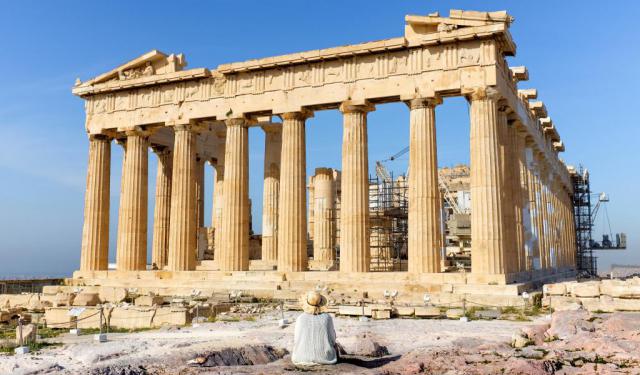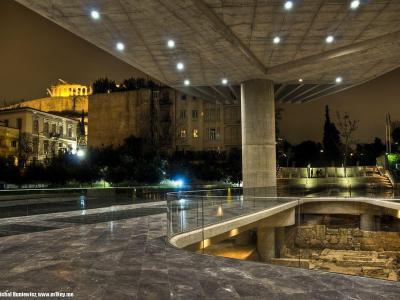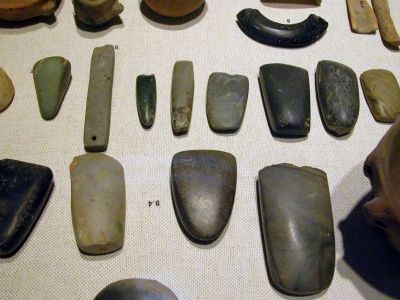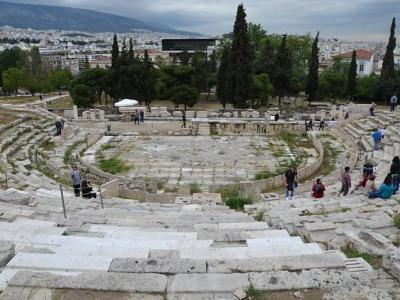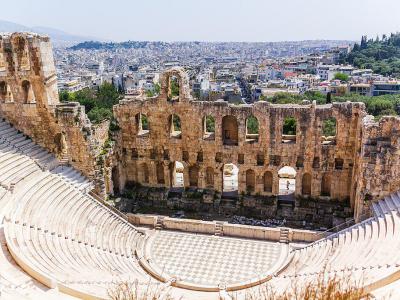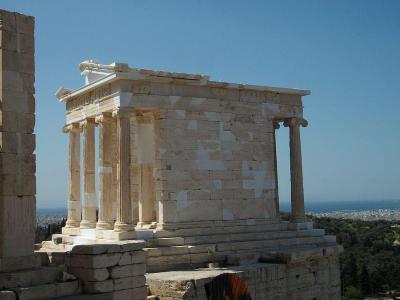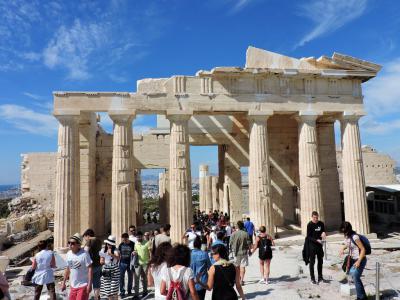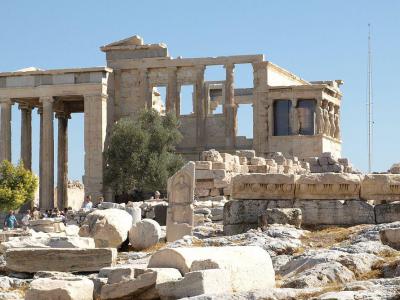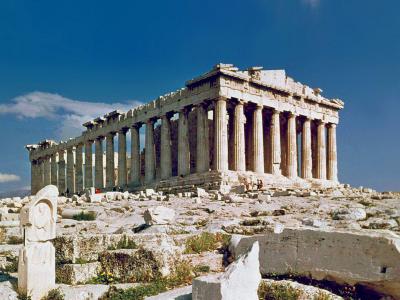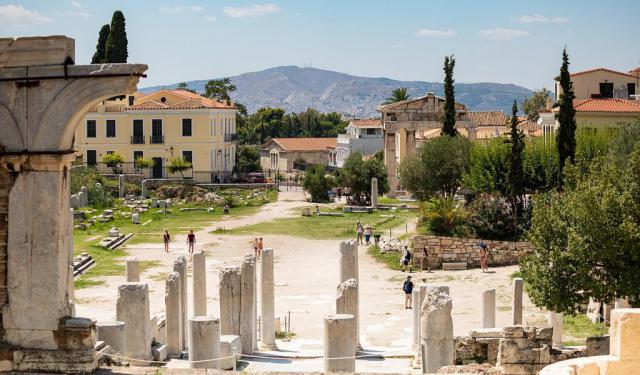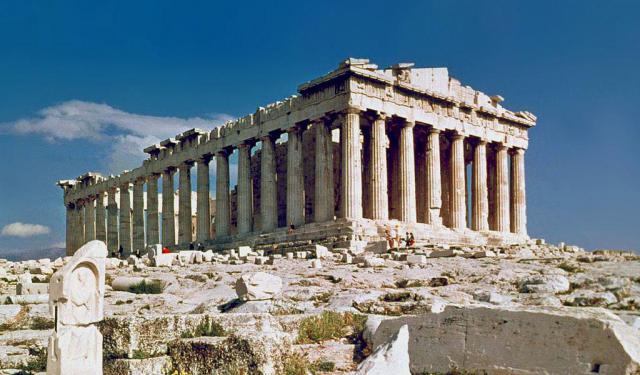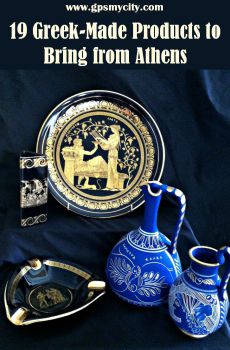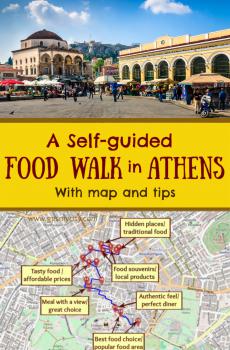Audio Guide: Walking Tour Around the Legendary Acropolis (Self Guided), Athens
Ah, the Acropolis of Athens-also known as "the sacred rock," because apparently, even rocks can have VIP status. This iconic hill has been home to temples, sanctuaries, and centuries of drama (both the theatrical and the historical kind). The ancient Greeks held this place in such high regard that they built architectural marvels that still dominate the city’s skyline. You can spot the Acropolis from almost anywhere in Athens, which only reinforces the feeling that it remains the true heart of the city.
The word "Acropolis" comes from the Greek "ákro" (which means the highest point) and "polis" (for town), perhaps because back then creativity in naming things was not a priority. The first known settlements here date back to the Neolithic period, meaning people have been climbing this hill for quite a long time.
Before sprinting up the hill, warm up your brain at the Acropolis Museum, where sculptures, artifacts, and fragments of the Parthenon’s glory are displayed in all their splendor. For those craving a deeper dive into archaeological detective work, the Museum of the Center for Acropolis Studies is where the real research magic happens.
At the base of the Acropolis sits the Theater of Dionysus, where Greek playwrights like Sophocles and Euripides premiered their “blockbuster” tragedies ages ago. Right next door is the Odeon of Herodes Atticus, a Roman-era amphitheater that still hosts performances-because if something worked in 161 AD, why mess with it?
Hiking up the Acropolis, you’ll encounter the Temple of Athena Nike, a compact but mighty tribute to the goddess of victory. Then, the Propylaea-a dramatic entrance gate so grand that even modern-day lobbies look uninspired in comparison.
The Erechtheion, with its legendary stone ladies holding up a porch (also known as Caryatids), is another must-see. These sculpted women have been doing their job for centuries with no complaints-so take due note, modern architects!
And finally, the Parthenon-the rockstar of ancient Greek architecture. This temple to Athena, the city’s patron goddess, is the crown jewel of the Acropolis. Walk around it and enjoy panoramic views that will make your Instagram followers jealous.
If your mission is to explore, note that the Acropolis isn’t just a collection of ruins-it’s a portal to Athens’ golden age. So, follow our self-guided tour and conquer this ancient hill like the modern explorer you are!
The word "Acropolis" comes from the Greek "ákro" (which means the highest point) and "polis" (for town), perhaps because back then creativity in naming things was not a priority. The first known settlements here date back to the Neolithic period, meaning people have been climbing this hill for quite a long time.
Before sprinting up the hill, warm up your brain at the Acropolis Museum, where sculptures, artifacts, and fragments of the Parthenon’s glory are displayed in all their splendor. For those craving a deeper dive into archaeological detective work, the Museum of the Center for Acropolis Studies is where the real research magic happens.
At the base of the Acropolis sits the Theater of Dionysus, where Greek playwrights like Sophocles and Euripides premiered their “blockbuster” tragedies ages ago. Right next door is the Odeon of Herodes Atticus, a Roman-era amphitheater that still hosts performances-because if something worked in 161 AD, why mess with it?
Hiking up the Acropolis, you’ll encounter the Temple of Athena Nike, a compact but mighty tribute to the goddess of victory. Then, the Propylaea-a dramatic entrance gate so grand that even modern-day lobbies look uninspired in comparison.
The Erechtheion, with its legendary stone ladies holding up a porch (also known as Caryatids), is another must-see. These sculpted women have been doing their job for centuries with no complaints-so take due note, modern architects!
And finally, the Parthenon-the rockstar of ancient Greek architecture. This temple to Athena, the city’s patron goddess, is the crown jewel of the Acropolis. Walk around it and enjoy panoramic views that will make your Instagram followers jealous.
If your mission is to explore, note that the Acropolis isn’t just a collection of ruins-it’s a portal to Athens’ golden age. So, follow our self-guided tour and conquer this ancient hill like the modern explorer you are!
How it works: Download the app "GPSmyCity: Walks in 1K+ Cities" from Apple App Store or Google Play Store to your mobile phone or tablet. The app turns your mobile device into a personal tour guide and its built-in GPS navigation functions guide you from one tour stop to next. The app works offline, so no data plan is needed when traveling abroad.
Walking Tour Around the Legendary Acropolis Map
Guide Name: Walking Tour Around the Legendary Acropolis
Guide Location: Greece » Athens (See other walking tours in Athens)
Guide Type: Self-guided Walking Tour (Sightseeing)
# of Attractions: 8
Tour Duration: 1 Hour(s)
Travel Distance: 1.0 Km or 0.6 Miles
Author: emily
Sight(s) Featured in This Guide:
Guide Location: Greece » Athens (See other walking tours in Athens)
Guide Type: Self-guided Walking Tour (Sightseeing)
# of Attractions: 8
Tour Duration: 1 Hour(s)
Travel Distance: 1.0 Km or 0.6 Miles
Author: emily
Sight(s) Featured in This Guide:
- Acropolis Museum
- Museum of the Center for Acropolis Studies
- Theater of Dionysus
- Odeon of Herodes Atticus
- Temple of Athena Nike
- Propylaea
- Erechtheion
- Parthenon
1) Acropolis Museum (must see)
Welcome to the Acropolis Museum, where ancient history meets sleek modern design-because nothing says “let’s preserve the past” quite like this four-story glass fortress perched atop millennia of buried treasures. Since 2009, this museum has housed every artifact unearthed from the Acropolis, making it the ultimate attic of Athenian greatness.
Step inside, and you’re greeted by an ancient owl-Athena’s favorite bird, dating back to 500 BC-watching over visitors with an expression that says, “I’ve seen it all.” As for the exhibits, there's a dazzling array of freestanding sculptures, marble figures, and friezes, each with a story to tell (if only marble could talk). And for a touch of drama, the museum’s glass floors and walkways let you peer down at the remains of an ancient civilization, like an archaeological reality show in progress.
The collections follow a timeline, beginning with finds from the Acropolis slopes-statues, reliefs, and pieces from the Sanctuary of Asclepius, the god of healing (who, let’s be honest, would have had his hands full in ancient Athens). Move on to the Archaic Collection, displayed in a soaring gallery, where mythological scenes play out in painted pediments-think Hercules wrestling monsters long before superhero movies were a thing. One level down, the post-Parthenon Collection showcases sculptures from the Temple of Athena Nike, architectural gems from the Propylaea, and five of the six legendary Caryatids from the Erechtheion (the sixth is currently “on leave” at the British Museum).
Cool, organized, and mercifully air-conditioned, the Acropolis Museum offers a captivating dive into ancient Athenian life-complete with multimedia presentations and expert guides ready to unravel centuries of history.
Tip:
Start with the video on the third floor, then work your way down through history. And when your brain needs a break, the second-floor terrace awaits-with panoramic views and a café serving Greek cuisine that even the gods would approve of.
Step inside, and you’re greeted by an ancient owl-Athena’s favorite bird, dating back to 500 BC-watching over visitors with an expression that says, “I’ve seen it all.” As for the exhibits, there's a dazzling array of freestanding sculptures, marble figures, and friezes, each with a story to tell (if only marble could talk). And for a touch of drama, the museum’s glass floors and walkways let you peer down at the remains of an ancient civilization, like an archaeological reality show in progress.
The collections follow a timeline, beginning with finds from the Acropolis slopes-statues, reliefs, and pieces from the Sanctuary of Asclepius, the god of healing (who, let’s be honest, would have had his hands full in ancient Athens). Move on to the Archaic Collection, displayed in a soaring gallery, where mythological scenes play out in painted pediments-think Hercules wrestling monsters long before superhero movies were a thing. One level down, the post-Parthenon Collection showcases sculptures from the Temple of Athena Nike, architectural gems from the Propylaea, and five of the six legendary Caryatids from the Erechtheion (the sixth is currently “on leave” at the British Museum).
Cool, organized, and mercifully air-conditioned, the Acropolis Museum offers a captivating dive into ancient Athenian life-complete with multimedia presentations and expert guides ready to unravel centuries of history.
Tip:
Start with the video on the third floor, then work your way down through history. And when your brain needs a break, the second-floor terrace awaits-with panoramic views and a café serving Greek cuisine that even the gods would approve of.
2) Museum of the Center for Acropolis Studies
Step inside the Weiler Building, a structure that’s been through quite the career shift. Built in 1836 by a Bavarian engineer, it started off as, well, just a building. Then, it dabbled in healthcare as a military hospital, did a stint in law enforcement as a gendarmes barracks, and finally found its true calling-as a museum. And not just any museum! This place is a behind-the-scenes gem, an extension of the Acropolis Museum’s research workshops, where history isn’t just preserved-it’s brought back to life.
What’s inside? A treasure trove of ancient wonders! There are casts of Parthenon sculptures, including the dramatic pediment figures and battle-ready Metopes from the Trojan War. You’ll see friezes, architectural models, and even paintings depicting what the Propylaea monumental gateway looked like in its prime. And for the archaeology buffs-yes, there’s even an active dig site right here!
Now, let’s talk about the gift shop. This isn’t your average fridge-magnet-and-keychain kind of place. Expect beautiful books for kids, handcrafted jewelry, and other high-quality finds. And if all that history makes you thirsty, the café serves up more than just coffee-delivering the best view of the Acropolis in Athens, too. Sure, the prices here might make you raise an eyebrow, but hey-can you really put a price on sipping coffee with an ancient wonder as your backdrop? Come see for yourself!
What’s inside? A treasure trove of ancient wonders! There are casts of Parthenon sculptures, including the dramatic pediment figures and battle-ready Metopes from the Trojan War. You’ll see friezes, architectural models, and even paintings depicting what the Propylaea monumental gateway looked like in its prime. And for the archaeology buffs-yes, there’s even an active dig site right here!
Now, let’s talk about the gift shop. This isn’t your average fridge-magnet-and-keychain kind of place. Expect beautiful books for kids, handcrafted jewelry, and other high-quality finds. And if all that history makes you thirsty, the café serves up more than just coffee-delivering the best view of the Acropolis in Athens, too. Sure, the prices here might make you raise an eyebrow, but hey-can you really put a price on sipping coffee with an ancient wonder as your backdrop? Come see for yourself!
3) Theater of Dionysus (must see)
Comfortably set on the sun-kissed southern slopes of the Acropolis, the Theater of Dionysus is where drama as we know it was born. That’s right, before Broadway and Hollywood, this was the place where the ancient Greeks gathered to watch tragic heroes suffer and comic fools make a mess of things.
Now, why here, you ask? Well, it's all about the location! The theater sits conveniently close to the Temple of Dionysus, the god of wine, revelry, and, conveniently, drama. Every year in the 5th century BC, the Greeks threw a Dionysian festival-a six-day extravaganza filled with theatrical competitions where poets battled for glory. Imagine Aeschylus, Sophocles, and Euripides, nervously pacing backstage, hoping their tragedies would win over the crowd. The stakes? – Public honor, a handsome cash prize, and eternal bragging rights.
Fast forward a few centuries, and the Romans come in, super-sizing the place into a 17,000-seat venue. They even turned it into a gladiatorial arena-because, let’s be honest, they loved a bit of blood sport (more than sheer drama). Safety first, though! They added a fancy marble balustrade with metal railings to keep the audience from, well… joining the fight.
And here’s a fun detour-above the theater, you’ll find a cave dedicated to Artemis, the goddess of hunting, wilderness, wild animals, transitions, nature, vegetation, and childbirth. In the Byzantine era, this became the Our Lady of the Cave chapel, a place where desperate mothers brought their sick children, hoping for a miracle cure.
Today, the Theater of Dionysus stands as a timeless tribute to Athens’ cultural legacy. Take a seat on those ancient stones, soak in the atmosphere, and remember-you’re sitting where Western theater literally took center stage.
Now, why here, you ask? Well, it's all about the location! The theater sits conveniently close to the Temple of Dionysus, the god of wine, revelry, and, conveniently, drama. Every year in the 5th century BC, the Greeks threw a Dionysian festival-a six-day extravaganza filled with theatrical competitions where poets battled for glory. Imagine Aeschylus, Sophocles, and Euripides, nervously pacing backstage, hoping their tragedies would win over the crowd. The stakes? – Public honor, a handsome cash prize, and eternal bragging rights.
Fast forward a few centuries, and the Romans come in, super-sizing the place into a 17,000-seat venue. They even turned it into a gladiatorial arena-because, let’s be honest, they loved a bit of blood sport (more than sheer drama). Safety first, though! They added a fancy marble balustrade with metal railings to keep the audience from, well… joining the fight.
And here’s a fun detour-above the theater, you’ll find a cave dedicated to Artemis, the goddess of hunting, wilderness, wild animals, transitions, nature, vegetation, and childbirth. In the Byzantine era, this became the Our Lady of the Cave chapel, a place where desperate mothers brought their sick children, hoping for a miracle cure.
Today, the Theater of Dionysus stands as a timeless tribute to Athens’ cultural legacy. Take a seat on those ancient stones, soak in the atmosphere, and remember-you’re sitting where Western theater literally took center stage.
4) Odeon of Herodes Atticus
The Odeon of Herodes Atticus-or, as locals call it, the Herodeion. This name sounds like it belongs to an ancient superhero, but in reality, it’s a grand stone amphitheater sitting snug at the foot of the Acropolis. Built in 161 AD by a Greek aristocrat with a Roman title, Herodes Atticus, this wasn’t just any vanity project-it was a love letter to his late wife. And what better way to say “I miss you” than with a massive, acoustically perfect concert hall?
Originally, the Herodeion played host to the finest musical and theatrical performances of the ancient world-think tragic dramas, soaring choral arrangements, and instrumental masterpieces. The kind of cultural flex that made Athens the place to be. With no remnants of a roof (aside from the cedar one that once covered the orchestra area), this was an open-air spectacle from the very start.
A couple of millennia on, the Herodeion is still in business. By day, it’s a stunning ruin that whispers tales of the past. By night, it transforms into one of the dreamiest venues on Earth, hosting classical concerts, modern theater, and international acts beneath the Athenian moon.
Tip:
If you're planning a trip to Athens, check the event schedule ahead of time-nothing ruins a perfect ancient Greek night out like realizing all the tickets are gone. And since this is an open-air gig, always keep an eye on the weather. Rain or shine, though, this place remains one of the most breathtaking remnants of an era when entertainment was truly larger than life.
Originally, the Herodeion played host to the finest musical and theatrical performances of the ancient world-think tragic dramas, soaring choral arrangements, and instrumental masterpieces. The kind of cultural flex that made Athens the place to be. With no remnants of a roof (aside from the cedar one that once covered the orchestra area), this was an open-air spectacle from the very start.
A couple of millennia on, the Herodeion is still in business. By day, it’s a stunning ruin that whispers tales of the past. By night, it transforms into one of the dreamiest venues on Earth, hosting classical concerts, modern theater, and international acts beneath the Athenian moon.
Tip:
If you're planning a trip to Athens, check the event schedule ahead of time-nothing ruins a perfect ancient Greek night out like realizing all the tickets are gone. And since this is an open-air gig, always keep an eye on the weather. Rain or shine, though, this place remains one of the most breathtaking remnants of an era when entertainment was truly larger than life.
5) Temple of Athena Nike (must see)
The Temple of Athena Nike-a tiny, jewel-box of a temple perched atop the Acropolis. At just 11 feet (or 3.3 meters, for the metric-minded), it’s easy to miss in the shadow of its grander neighbors. But rest assured, it’s well worth a closer look. As you pass through the mighty Propylaea Gate, sneak a glance to your upper right-there it is, standing proudly on the edge of the rock wall, as if keeping an eye on everything below.
This little temple has had a rough ride through history, being knocked down not once, but twice! Thankfully, the ancient puzzle pieces were carefully put back together using original fragments, restoring its elegant form. And what a form it is-four Ionic columns at each end, perfectly symmetrical, just as it was in 420 BC. Back in the day, Athenians gathered here to toast their victories over the Persians (its frieze even depicts scenes from the Battle of Plataea in 479 BC-because what’s a victory without some artistic bragging?).
Designed by the architect Kallikrates, this temple wasn’t just for show. It served as both a shrine and a lookout post-because even the goddess of victory needs a good vantage point. Speaking of which, the temple’s balustrade once featured a stunning sculpture of Athena Nike. But there’s a twist! Unlike your usual winged depiction of the goddess, this one is wingless-a symbolic way of saying, “Victory is staying right here in Athens, thank you very much.”
And then there’s the legend. This very spot is where King Aegeus is said to have waited anxiously for his son, Theseus, to return from slaying the Minotaur in Crete. The plan? If Theseus survived, he’d raise white sails instead of black. The reality? He forgot. And when poor Aegeus saw the black sails, he assumed the worst and hurled himself into the sea-thus giving the Aegean Sea its name. Talk about a tragic mix-up...
So next time you visit the Acropolis, don’t just rush to the Parthenon. Take a moment to appreciate this small but mighty temple-because in Athens, even the little things come with epic stories.
This little temple has had a rough ride through history, being knocked down not once, but twice! Thankfully, the ancient puzzle pieces were carefully put back together using original fragments, restoring its elegant form. And what a form it is-four Ionic columns at each end, perfectly symmetrical, just as it was in 420 BC. Back in the day, Athenians gathered here to toast their victories over the Persians (its frieze even depicts scenes from the Battle of Plataea in 479 BC-because what’s a victory without some artistic bragging?).
Designed by the architect Kallikrates, this temple wasn’t just for show. It served as both a shrine and a lookout post-because even the goddess of victory needs a good vantage point. Speaking of which, the temple’s balustrade once featured a stunning sculpture of Athena Nike. But there’s a twist! Unlike your usual winged depiction of the goddess, this one is wingless-a symbolic way of saying, “Victory is staying right here in Athens, thank you very much.”
And then there’s the legend. This very spot is where King Aegeus is said to have waited anxiously for his son, Theseus, to return from slaying the Minotaur in Crete. The plan? If Theseus survived, he’d raise white sails instead of black. The reality? He forgot. And when poor Aegeus saw the black sails, he assumed the worst and hurled himself into the sea-thus giving the Aegean Sea its name. Talk about a tragic mix-up...
So next time you visit the Acropolis, don’t just rush to the Parthenon. Take a moment to appreciate this small but mighty temple-because in Athens, even the little things come with epic stories.
6) Propylaea
The Propylaea, the grand entrance to the Acropolis-because even in ancient Greece, you needed a proper gateway to impress your guests. Every year, thousands of visitors pass through this monumental doorway, retracing the steps of philosophers, warriors, and possibly a few very lost tourists from antiquity. Now, if you’re wondering where the original staircase went… well, time took care of that. Instead, modern pathways guide you in and out, making your ascent a little smoother than what ancient Athenians might have experienced.
Designed by architect Mnesicles-who clearly had an eye for drama-the Propylaea was built between 437 and 432 BC, proving that even the entrances in Athens had to be masterpieces. The structure boasts a central building flanked by two wings, with Doric columns holding things down on the east and west, while Ionic columns add a bit of flair in the middle. This was actually the first classical structure to mix Doric and Ionic styles so visibly-like an architectural trendsetter before trends were a thing. The ceiling? – It was originally painted with a heavenly scene, just in case the sky itself wasn’t impressive enough.
Now, picture this: ancient pilgrims making their way through, as five heavy wooden doors opened one by one-like the ultimate suspenseful reveal. To the north, the only fully completed room, the Pinakotheke, served as a resting spot for visitors and doubled as an art gallery. According to the geographer Pausanias, its walls once displayed stunning frescoes and paintings.
Through Greek, Roman, and Byzantine rule, the Propylaea stood strong-until 1656, when an unfortunate explosion turned part of it into rubble. Thankfully, restoration efforts since 1984 have helped bring some of its lost grandeur back.
Tip:
Just beyond the Propylaea, on your right, you’ll spot the remains of the Sanctuary of Artemis Brauronia, dating back to the 4th century BC. Because why stop at one historical marvel when you can have two?
Designed by architect Mnesicles-who clearly had an eye for drama-the Propylaea was built between 437 and 432 BC, proving that even the entrances in Athens had to be masterpieces. The structure boasts a central building flanked by two wings, with Doric columns holding things down on the east and west, while Ionic columns add a bit of flair in the middle. This was actually the first classical structure to mix Doric and Ionic styles so visibly-like an architectural trendsetter before trends were a thing. The ceiling? – It was originally painted with a heavenly scene, just in case the sky itself wasn’t impressive enough.
Now, picture this: ancient pilgrims making their way through, as five heavy wooden doors opened one by one-like the ultimate suspenseful reveal. To the north, the only fully completed room, the Pinakotheke, served as a resting spot for visitors and doubled as an art gallery. According to the geographer Pausanias, its walls once displayed stunning frescoes and paintings.
Through Greek, Roman, and Byzantine rule, the Propylaea stood strong-until 1656, when an unfortunate explosion turned part of it into rubble. Thankfully, restoration efforts since 1984 have helped bring some of its lost grandeur back.
Tip:
Just beyond the Propylaea, on your right, you’ll spot the remains of the Sanctuary of Artemis Brauronia, dating back to the 4th century BC. Because why stop at one historical marvel when you can have two?
7) Erechtheion (must see)
The Erechtheion-a temple with a front-row seat to one of the pettiest godly rivalries in history. Built between 421 and 406 BC, this elegant structure was dedicated to Athena (the goddess of wisdom, warfare, and handicraft) and Poseidon (the god of the sea), who once had a dramatic showdown over who would get Athens as their VIP city. Poseidon, ever the dramatic type, slammed his trident into the rock, and-voilà-a saltwater spring appeared. Impressive, but not exactly practical for drinking. Athena, on the other hand, planted an olive tree, which was far more useful for making oil, food, and, let’s be honest, rubbing into everything. The locals made their choice, and Athena took the crown as the city’s patron. Poseidon? Well, let’s just say he didn’t take it well, but they eventually made peace. Allegedly, you can still see where his trident threw a tantrum on the temple’s ground.
The Erechtheion wasn’t just a temple-it was an architectural masterpiece, showcasing the graceful Ionic style. Inside, there were three chambers: one for the sacred olivewood statue of Athena, and the others for Poseidon, presumably as a consolation prize. The temple’s north, east, and south sides were framed by grand porticoes, but the real showstopper? The Porch of the Caryatids, where six elegantly sculpted female figures held up the roof with their heads-because who needs columns when you have ancient supermodels? The ones you see today are replicas; the originals are safely housed in the Acropolis Museum, away from pollution, weather, and pigeon-related hazards.
As history marched on, the Erechtheion saw some... unexpected tenants. In 1463, it was converted into a harem for the Ottoman commander’s wives-probably not what the ancient Greeks had in mind. Later, during the Greek War of Independence, a Turkish shell crashed into it, causing significant damage. Despite all this, the Erechtheion still stands, now a UNESCO World Heritage site and a must-visit for history lovers and architecture buffs alike.
Tip:
Want the full story? A guided tour will give you all the juicy details. Prefer to wander solo? Visit in the morning to beat the heat, and don’t forget to bring water-there’s no ancient vending machine up there!
The Erechtheion wasn’t just a temple-it was an architectural masterpiece, showcasing the graceful Ionic style. Inside, there were three chambers: one for the sacred olivewood statue of Athena, and the others for Poseidon, presumably as a consolation prize. The temple’s north, east, and south sides were framed by grand porticoes, but the real showstopper? The Porch of the Caryatids, where six elegantly sculpted female figures held up the roof with their heads-because who needs columns when you have ancient supermodels? The ones you see today are replicas; the originals are safely housed in the Acropolis Museum, away from pollution, weather, and pigeon-related hazards.
As history marched on, the Erechtheion saw some... unexpected tenants. In 1463, it was converted into a harem for the Ottoman commander’s wives-probably not what the ancient Greeks had in mind. Later, during the Greek War of Independence, a Turkish shell crashed into it, causing significant damage. Despite all this, the Erechtheion still stands, now a UNESCO World Heritage site and a must-visit for history lovers and architecture buffs alike.
Tip:
Want the full story? A guided tour will give you all the juicy details. Prefer to wander solo? Visit in the morning to beat the heat, and don’t forget to bring water-there’s no ancient vending machine up there!
8) Parthenon (must see)
Presiding over the Acropolis like a timeless guardian of Athens, the Parthenon is one of the finest and most recognizable examples of classical architecture. This 5th-century BC temple was the brainchild of Pericles, the man who decided Athens needed an upgrade-preferably in glorious white Pentelic marble.
Replacing an older sanctuary, the Parthenon was dedicated to Athena, the city's patron goddess, whose grand 12-meter-tall statue, adorned in ivory and gold, once dazzled anyone lucky enough to lay eyes on it. More than just a temple, the Parthenon was a statement piece-loud and clear-about Athens' dominance following its victories in the Persian Wars and its leading role in the Delian League (uniting under its umbrella equal city-states against Persia). In other words, it wasn’t just about worship; it was about showing off.
Designed in the Doric style, the temple was built to withstand the test of time-but history had other plans. Over the centuries, it transformed from a Greek temple to a Byzantine church, then a Turkish mosque, and finally, in 1687, into a really unlucky storage facility for gunpowder. That decision ended about as well as you'd expect when the Venetians decided to bombard the Acropolis, causing a spectacular explosion. And if that wasn't enough, Lord Elgin of Great Britain came along in the 19th century and helped himself to much of its sculptural beauty, now sitting in the British Museum.
Yet, despite the looting, wars, and centuries of wear, the Parthenon still reigns supreme, standing as an enduring emblem of Greek culture and a favorite inspiration for neoclassical buildings worldwide.
Tips:
Go early-unless you enjoy waiting in long lines under the scorching Athenian sun.
Use both entrances to explore the site fully.
Get a combined ticket-it covers multiple iconic spots, including the Odeon of Herodes Atticus, the Theater of Dionysus, the Temple of Olympian Zeus, and the Ancient Agora. Because if you're traveling back in time, you might as well see it all.
Replacing an older sanctuary, the Parthenon was dedicated to Athena, the city's patron goddess, whose grand 12-meter-tall statue, adorned in ivory and gold, once dazzled anyone lucky enough to lay eyes on it. More than just a temple, the Parthenon was a statement piece-loud and clear-about Athens' dominance following its victories in the Persian Wars and its leading role in the Delian League (uniting under its umbrella equal city-states against Persia). In other words, it wasn’t just about worship; it was about showing off.
Designed in the Doric style, the temple was built to withstand the test of time-but history had other plans. Over the centuries, it transformed from a Greek temple to a Byzantine church, then a Turkish mosque, and finally, in 1687, into a really unlucky storage facility for gunpowder. That decision ended about as well as you'd expect when the Venetians decided to bombard the Acropolis, causing a spectacular explosion. And if that wasn't enough, Lord Elgin of Great Britain came along in the 19th century and helped himself to much of its sculptural beauty, now sitting in the British Museum.
Yet, despite the looting, wars, and centuries of wear, the Parthenon still reigns supreme, standing as an enduring emblem of Greek culture and a favorite inspiration for neoclassical buildings worldwide.
Tips:
Go early-unless you enjoy waiting in long lines under the scorching Athenian sun.
Use both entrances to explore the site fully.
Get a combined ticket-it covers multiple iconic spots, including the Odeon of Herodes Atticus, the Theater of Dionysus, the Temple of Olympian Zeus, and the Ancient Agora. Because if you're traveling back in time, you might as well see it all.
Walking Tours in Athens, Greece
Create Your Own Walk in Athens
Creating your own self-guided walk in Athens is easy and fun. Choose the city attractions that you want to see and a walk route map will be created just for you. You can even set your hotel as the start point of the walk.
Plaka Attractions Walking Tour
Plaka, the oldest-and in many views, the most photogenic-district of Athens is where history isn’t just studied, it’s lived. Nestled at the foot of the mighty Acropolis, this is the "neighborhood of the Gods"-which sounds dramatic, but when you see it, you’ll understand why.
People have settled here since antiquity, so don’t be surprised if the walls seem to whisper ancient... view more
Tour Duration: 2 Hour(s)
Travel Distance: 3.6 Km or 2.2 Miles
People have settled here since antiquity, so don’t be surprised if the walls seem to whisper ancient... view more
Tour Duration: 2 Hour(s)
Travel Distance: 3.6 Km or 2.2 Miles
Athens Food Walking Tour
Traditional Greek cuisine is one of the healthiest in the world, and prices in all but the flashiest establishments afford excellent value. The prevalence of vegetable and dairy dishes makes eating out a delight for non-meat eaters. Carefully selected appetizers (tzatzíki, dolmádes, kalamarákia) can constitute a full meal. Greece’s most famous slow-cooked oven dish, however, is probably... view more
Tour Duration: 1 Hour(s)
Travel Distance: 2.2 Km or 1.4 Miles
Tour Duration: 1 Hour(s)
Travel Distance: 2.2 Km or 1.4 Miles
Walking Around the National Garden
The National Garden is an impressive, historic park in the center of Athens, complete with artificial streams and duck ponds. Formerly known as the Royal Garden, it was commissioned by King Otto’s queen, Amalia, in 1838, reason why it is located directly behind the Old Palace (currently the Greek Parliament building). Not only is it a welcome refuge from the swirl of traffic just outside the... view more
Tour Duration: 2 Hour(s)
Travel Distance: 3.3 Km or 2.1 Miles
Tour Duration: 2 Hour(s)
Travel Distance: 3.3 Km or 2.1 Miles
Athens Introduction Walking Tour
Athens, the cradle of Western Civilization and one of Europe's oldest cities, originated between the 4th and the 3rd millennia BC. The story of Athens stems from a mythological contest between the goddess of wisdom and warfare, Athena, and the god of the sea, Poseidon. Both deities vied to become the city's patron. Poseidon's gift of a saltwater spring was deemed impractical,... view more
Tour Duration: 3 Hour(s)
Travel Distance: 4.2 Km or 2.6 Miles
Tour Duration: 3 Hour(s)
Travel Distance: 4.2 Km or 2.6 Miles
Useful Travel Guides for Planning Your Trip
14 Best Cafes in Athens
While in Athens it is immediately noticeable that the local cafe culture thriving. Through this directory you will get a chance to visit very different establishments, ranging from "kafenia", to hip, modern coffee shops and get first hand experience of the diversity of contemporary Greek...
Souvenirs Shopping: 19 Uniquely Greek Products to Bring from Athens
A cradle of European civilization, Greece, in general, and Athens, in particular, have long been - from the days of the Roman Empire up until present - the lure for travelers and history buffs seeking to find and bring home something memorable. Today's Athens (much as its ancient self) offers a...
A Self-Guided Food Walk in Athens
Just as many things in Greece, dining in Athens is very much laid-back with the majority of local eateries seeing patrons begin to congregate for dinner only after 8 pm. Eating-wise, the Athenians favor simplicity, leaning to the more casual and not so pricey tavernas where food is plentiful. To...
The Most Popular Cities
/ view all
